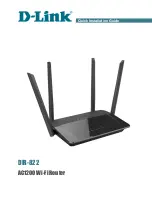
Chapter 21 Classifier
GS1920v2 Series User’s Guide
189
Layer 3
Specify the fields below to configure a layer 3 classifier.
DSCP
IPv4/IPv6
Select
Any
to classify traffic from any DSCP or select the second option and specify a DSCP (DiffServ
Code Point) number between 0 and 63 in the field provided.
Preceden
ce
Select
Any
to classify traffic from any precedence or select the second option and specify an IP
Precedence (the first 3 bits of of the 8-bit ToS field) value between 0 and 7 in the field provided.
ToS
Select
Any
to classify traffic from any ToS or select the second option and specify Type of Service (the
last 5 bits of the 8-bit ToS field) value between 0 and 255 in the field provided.
IP Protocol
Select an IPv4 protocol type or select
O the r
and enter the protocol number in decimal value. Refer to
Table 75 on page 191
for more information.
You may select
Esta b lish O nly
for
TC P
protocol type. This means that the Switch will pick out the
packets that are sent to establish TCP connections.
IPv6 Next
Header
Select an IPv6 protocol type or select
O the r
and enter an 8-bit next header in the IPv6 packet. The
Next Header field is similar to the IPv4 Protocol field. The IPv6 protocol number ranges from 1 to 255.
You may select
Esta b lish O nly
for
TC P
protocol type. This means that the Switch will identify packets
that initiate or acknowledge (establish) TCP connections.
Source
IP
Address/
Address
Prefix
Enter a source IP address in dotted decimal notation.
Specify the address prefix by entering the number of ones in the subnet mask.
A subnet mask can be represented in a 32-bit notation. For example, the subnet mask “255.255.255.0”
can be represented as “11111111.11111111.11111111.00000000”, and counting up the number of
ones in this case results in 24.
Destination
IP
Address/
Address
Prefix
Enter a destination IP address in dotted decimal notation.
Specify the address prefix by entering the number of ones in the subnet mask.
Layer 4
Specify the fields below to configure a layer-4 classifier.
Source
Socket
Number
Note: You must select either
UDP
or
TC P
in the
IP Pro to c o l
field before you configure the
socket numbers.
Select
Any
to apply the rule to all TCP/UDP protocol port numbers or select the second option and
enter a TCP/UDP protocol port number. Refer to
Table 76 on page 191
for more information.
Destination
Socket
Number
Note: You must select either
UDP
or
TC P
in the
IP Pro to c o l
field before you configure the
socket numbers.
Select
Any
to apply the rule to all TCP/UDP protocol port numbers or select the second option and
enter a TCP/UDP protocol port number. Refer to
Table 76 on page 191
for more information.
Add
Click
Add
to insert the entry in the summary table below and save your changes to the Switch’s run-
time memory. The Switch loses these changes if it is turned off or loses power, so use the
Sa ve
link on
the top navigation panel to save your changes to the non-volatile memory when you are done
configuring.
Table 72 Advanced Application > Classifier > Classifier Configuration (continued)
LABEL
DESC RIPTIO N
Содержание GS1920-48HPv2
Страница 19: ...19 PA RT I Use r s Guide...
Страница 43: ...43 PA RT II T e c hnic al Re fe re nc e...
Страница 124: ...Chapter 9 VLAN GS1920v2 Series User s Guide 124 Figure 97 Advanced Application VLAN Port Based VLAN Setup Port Isolation...
Страница 155: ...Chapter 13 Spanning Tree Protocol GS1920v2 Series User s Guide 155 Figure 118 MSTP and Legacy RSTP Network Example...
Страница 193: ...GS1920v2 Series User s Guide 193 Figure 140 Classifier Example...
Страница 224: ...Chapter 24 Multicast GS1920v2 Series User s Guide 224 Figure 162 MVR Group Configuration Example 2 EXAMPLE...
Страница 367: ...Chapter 40 Access Control GS1920v2 Series User s Guide 367 Figure 271 Example Lock Denoting a Secure Connection EXAMPLE...
Страница 388: ...Chapter 48 Configure Clone GS1920v2 Series User s Guide 388 Figure 284 Management Configure Clone...
















































